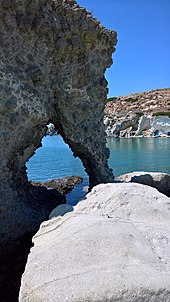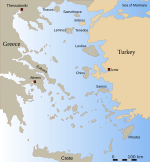Kimolos
In the Middle Ages it was known as Argentiera (Greek: Αρτζεντιέρα), because of the silver-colored rocky lands of its southern coast.The highest point is mount Paleokastro, at 364 metres (1,194 feet)[3] The main settlement is the Chorio, located on a hill on the south-east of the island.Large areas of Kimolos are covered by tuffs and the volcanic activity can be obvious from the hot springs, existence of a notable geothermal field, the characteristic landscape and strange landforms.Theodore Bent in December 1883 noted “a sort of white porous stone, easy to cut and much prized for building, for it hardens with time; it is the old 'terra Kimolia', out of which the ancients made Fuller's earth.”[6] One of the most famous geologic formations on Kimolos is Skiadi.Most of the working population is involved with the tourist industry of the island (hotels, restaurants) in combination with agriculture activities, mainly during winter.On the island all vehicles are permitted, but during the summer months, the lack of parking space is the most important problem in populated areas, such as Chorio Kimolou and Psathi.



MunicipalityGreeceAdministrative regionSouth AegeanRegional unitTime zonePostal codeArea code(s)Vehicle registrationGreek islandAegean SeaCycladesPolyaigosAncient AthensSpartaMiddle AgesOttoman EmpiresilicaTheodore BentFuller's earthablationMilos regional unitPiraeusAthensKimon DigenisList of islands of GreeceTurkeyAegean civilizationsAegean disputeAegean IslandsGreek islandsTurkish islandsAmorgosAnanesAndrosAntimilosAntiparosDaskalioDespotikoDonousaFolegandrosGyarosIrakleiaKardiotissaKoufonisiaKythnosMykonosRineiaSantoriniSchoinoussaSerifopoulaSerifosSifnosSikinosTherasiaDodecaneseAgathonisiAlimiaArmathiaAstypalaiaÇataladaFarmakonisiKalolimnosKalymnosKara AdaKarpathosKinarosKüçük Tavşan AdasıLeipsoiLevithaNisyrosPatmosPserimosRhodesSalih AdaTelendosZaforasNorth AegeanAgios EfstratiosAgios MinasAmmoulianiAyvalık IslandsBüyük AdaChryseFoça IslandsFournoi KorseonIcariaImbrosKoukonesiLemnosLesbosMegalonisiMetelik IslandOinoussesSamiopoulaSamothraceTenedosThasosThymainaUzunadaZourafaSaronicAeginaAgios GeorgiosAgistriPsyttaleiaSalamisSpetsesSporadesAdelfoi IsletsAlonnisosEriniaGiouraKyra PanagiaPeristeraPiperiPsathouraSarakinoSkantzouraSkiathosSkopelosSkyropoulaSkyrosTsoungriaValaxaAfentis Christos